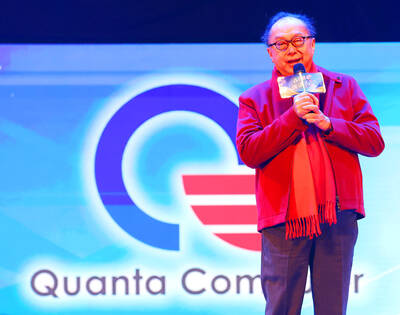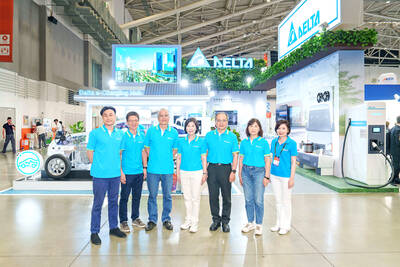LCD panel maker AU Optronics Corp (AUO, 友達光電) yesterday reported that net profit for last quarter more than halved as a persistent decline in TV panel prices eroded gross margin and drove down its bottom line to the weakest level in one-and-a-half years.
Net profit tumbled 52.6 percent to NT$4.2 billion (US$143.49 million) during the three-month period ending in December last year, compared with NT$8.86 billion in the third quarter of last year. That represented a 53 percent slump from NT$8.97 billion a year earlier, a financial statement showed.
Gross margin slid to 13.9 percent after panel prices fell 5.6 percent, compared with 17.5 percent in the prior quarter and 18.8 percent a year earlier.
Last year as a whole, net profit more than quadrupled to NT$32.36 billion, compared with NT$7.82 billion in 2016.
That marked the firm’s strongest annual net profit since 2008.
“Last year was the fifth consecutive profitable year for AUO, which is rarely seen in the LCD panel industry,” AUO chairman Paul Peng (彭双浪) told investors.
This year “is the best of times and the worst of times. It is a year full of challenges and opportunities for AUO,” Peng said. “Nonstop and dramatic capacity expansion from Chinese players might make oversupply a new norm.”
China is expected to become the largest-capacity supplier, surpassing Taiwan, Japan and South Korea, Peng added.
To brace for the change in the competition landscape, AUO said it aims to boost capacity cautiously and intelligently, while producing higher-priced, niche flat panels.
“We will not rush to join the capacity race, although 10.5G factories and OLED [organic LED] panels have become hot topics,” Peng said.
OLED panels are not a cure-all for flagship smartphones in light of the lukewarm sales of some handset brands, he said.
“We intend to maintain an optimal scale. Big is not necessarily beautiful,” Peng said.
AUO said it plans to ramp up production of 65-inch 8K TV panels in the first half of this year to cope with increasing demand for such ultra-high-resolution screens.
The firm said it would also produce more 18:9 aspect ratio handset panels, as they are becoming a “must-have” for mid to high-end smartphones.
AUO plans to increase capital spending slightly to NT$45 billion this year, from NT$43.9 billion last year.
The company also plans to ramp up production of a new 8.5G production line in the second half of the year.
AUO said it expects worldwide panel supply this year to grow between 6 percent and 8 percent year-on-year, approaching the growth of panel demand as developed countries enter a new TV replacement cycle.
However, the first quarter will still be a slack period, AUO said, adding that downward price adjustments are to extend from last quarter into this quarter, attributable primarily to shrinking TV demand.
Average selling prices for PC and TV panels are to dip by a low-single-digit percentage this quarter, while shipments of those panels are to contract by a mid-to-high-single digit percentage, AUO said.

Quanta Computer Inc (廣達) chairman Barry Lam (林百里) is expected to share his views about the artificial intelligence (AI) industry’s prospects during his speech at the company’s 37th anniversary ceremony, as AI servers have become a new growth engine for the equipment manufacturing service provider. Lam’s speech is much anticipated, as Quanta has risen as one of the world’s major AI server suppliers. The company reported a 30 percent year-on-year growth in consolidated revenue to NT$1.41 trillion (US$43.35 billion) last year, thanks to fast-growing demand for servers, especially those with AI capabilities. The company told investors in November last year that

Intel Corp has named Tasha Chuang (莊蓓瑜) to lead Intel Taiwan in a bid to reinforce relations between the company and its Taiwanese partners. The appointment of Chuang as general manager for Intel Taiwan takes effect on Thursday, the firm said in a statement yesterday. Chuang is to lead her team in Taiwan to pursue product development and sales growth in an effort to reinforce the company’s ties with its partners and clients, Intel said. Chuang was previously in charge of managing Intel’s ties with leading Taiwanese PC brand Asustek Computer Inc (華碩), which included helping Asustek strengthen its global businesses, the company

Taiwanese suppliers to Taiwan Semiconductor Manufacturing Co. (TSMC, 台積電) are expected to follow the contract chipmaker’s step to invest in the US, but their relocation may be seven to eight years away, Minister of Economic Affairs J.W. Kuo (郭智輝) said yesterday. When asked by opposition Chinese Nationalist Party (KMT) Legislator Niu Hsu-ting (牛煦庭) in the legislature about growing concerns that TSMC’s huge investments in the US will prompt its suppliers to follow suit, Kuo said based on the chipmaker’s current limited production volume, it is unlikely to lead its supply chain to go there for now. “Unless TSMC completes its planned six

Power supply and electronic components maker Delta Electronics Inc (台達電) yesterday said it plans to ship its new 1 megawatt charging systems for electric trucks and buses in the first half of next year at the earliest. The new charging piles, which deliver up to 1 megawatt of charging power, are designed for heavy-duty electric vehicles, and support a maximum current of 1,500 amperes and output of 1,250 volts, Delta said in a news release. “If everything goes smoothly, we could begin shipping those new charging systems as early as in the first half of next year,” a company official said. The new